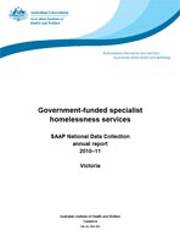Summary
This publication is one of eight state and territory supplements that accompany the 2010–11 annual report on the use of government-funded specialist homelessness services in Australia (AIHW 2011a). Information to aid readers in interpreting the data is presented in the national report and appendixes (AIHW 2011i).
In line with the national picture, Victorian service users:
- were mostly female
- were often relatively young
- were mostly non-Indigenous, however, Aboriginal and Torres Strait Islander people were over-represented relative to their population size
- commonly sought support because of interpersonal relationship, accommodation, or financial related issues
- immediately on exit from support, were most often living in a house or flat; were not employed; and had a government pension or benefit as their main source of income.
Some other points of interest in Victoria were:
- the rate of use of specialist homelessness services was higher than the national average
- the length of support was the shortest nationally
- the proportion of Aboriginal and Torres Strait Islander people was the lowest nationally
- there was a relatively high level of unmet need for specialist services, such as drug or alcohol support or intervention and specialist counselling.



